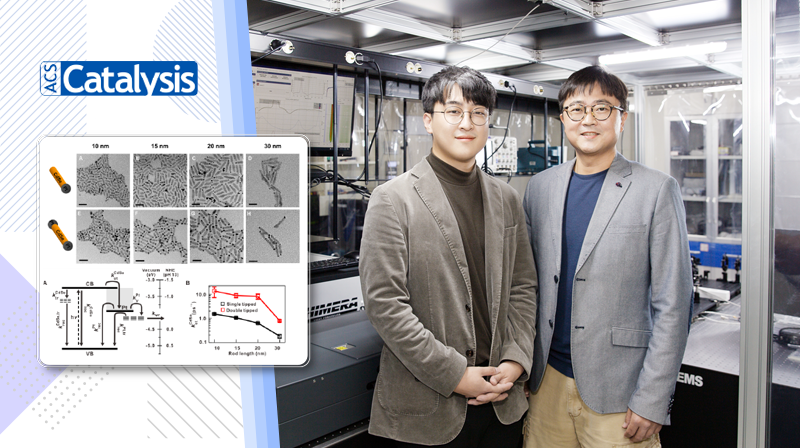A joint research team, affiliated with UNIST has unveiled the reaction dynamics of photocatalytic activity, which takes place within the hybrid metal-semiconductor nanostructures. Based on this, the research team offered a guideline for designing high-performance hybrid photocatalytic systems with optimal composition ratio and configuration of metal and semiconductor domains.
Published in the December 2021 issue of ACS Catalysis, this breakthrough has been led by Professor Oh-Hoon Kwon in the Department of Chemistry at UNIST, in collaboration with Professor Hyunjoon Song in the Department of Chemistry at KAIST.

Figure 1. TEM images of single-tipped (A–D) and double-tipped (E–H) CdSe nanorods with the average length of (A, E) 10 nm, (B, F) 15 nm, (C, G) 20 nm, and (D, H) 30 nm. The bars represent 20 nm.
In this study, the research team demonstrated the correlation of the rod length and the hydrogen-evolution rate using the well-defined single and double Pt-tipped CdSe nanorods with the aid of ultrafast spectroscopy.
According to the research team, both experimental and chemical kinetics studies univocally represent the optimal rod length of 15–20 nm on this one-dimensional metal–semiconductor hybrid catalyst for maximizing the hydrogen-evolution rate. It is mediated by two significant factors, that is, the electron-transfer rate from the semiconductor rods to the metal tips and the absorption cross section of the light-harvesting rods in the visible region, both of which depend on the rod length in opposite ways.
“We hope our findings guide us in choosing a suitable composition and configuration of metal–semiconductor hybrid photocatalysts and help us generalize the design of photocatalysts of two- and three-dimensional structures approaching practical catalytic systems,” noted the research team.
The findings of this research have been published in ACS Catalysis. This study has been supported by the National Research Foundation (NRF), funded by the Ministry of Science and ICT (MSIT). It has been also supported by the Samsung Advanced Institute of Technology (SAIT) and the Saudi-Aramco and KAIST CO2 management center.
Journal Reference
Ji Yong Choi, Won-Woo Park, Bumjin Park, et al., “Optimal Length of Hybrid Metal–Semiconductor Nanorods for Photocatalytic Hydrogen Generation,” ACS Catal., (2021).












